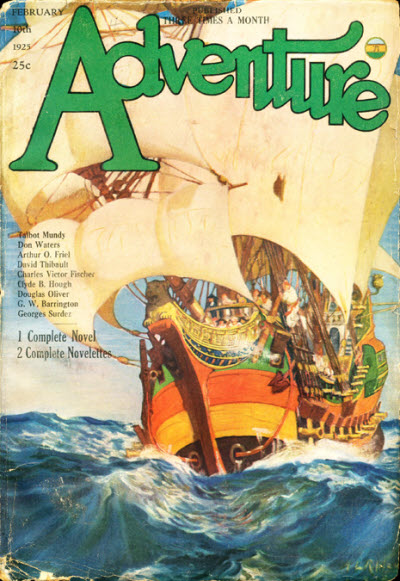Mundy Monday: “Tros of Samothrace”
Tros of Samothrace
Talbot Mundy described the adventures of Tros in three books: Tros of Samothrace, Queen Cleopatra and Purple Pirate. We will look at each of these books in turn and you can find them in paperback, hardcover, ebooks or here, at the invaluable library of Roy Glashan. Although Tros of Samothrace was originally serialized in the pages of Adventure magazine in 1925 and 1926, it was not published in book form until 1934--which is when Fritz Leiber read it--as it is a series of linked novellas that totaled more than 900 pages in the D. Appleton-Century Company edition.
The first novella is titled “Tros of Samothrace” and consists of what would become chapters 1 – 14 of the book of the same name. Set in the summer of the year 55 B.C., this story tells of Julius Caesar’s first invasion of Britain and those caught up in the turmoil of one of Caesar’s wars. It was first published in the February 10, 1925 issue of Adventure magazine.
Tros and his father Perseus are sent by the mystic leaders of Samothrace to the Britons to urge them to oppose Caesar with all their might; before they can deliver their message, they fall into Caesar’s hands and are pressed into his service. Tros is sent to Britain as one of Caesar’s spies and when he returns, he and his father must serve as pilots for Caesar’s invasion fleet or face death. Father and son then fight a war of wits with one of history’s greatest generals in an attempt to foil Caesar’s invasion of Britain.
Mundy introduces a finely drawn cast of characters (both fictional and historical) who come to life as friends or foes of Tros: Commius the client king of the Atrebates and spy for Caesar, Caswallon of the Catuvellauni and his queen Fflur who seek to defend Britain from Rome, and great Caesar himself. It is Fflur who introduces the element of the supernatural that distinguishes the Tros books from historical adventure; she has the Sight and can see the character of others and something their future.
Adventure, February 10, 1925
Then there is Conops. Conops is Tros’s bosun, but he is much more than that. He is the same age as Tros (mid-twenties) whom he has known since childhood; he has lost an eye to Roman brutality but he is Tros’s man and a born sailor who will not hesitate to use the long knife he is never without. He calls Tros ‘Master’ but he is a free man and is an example of the Man and Master concept in English literature. Where an American would associate the word ‘slave’ with the word ‘master’, many English authors use the concept of Man and Master to indicate a fierce, personal loyalty that is based on class and which is almost feudal in nature. Both H.R. Haggard and J.R.R. Tolkien used this to link characters to their heroes, most notably Tolkien with Samwise Gamgee’s devotion to his Mr. Frodo in the Lord of the Rings. Tros is not Frodo Baggins and Conops is not Sam, but I think that the one-eyed sailor from Samothrace and the gardener’s son from Hobbiton would understand each other quite well when it came to the protection and welfare of their respective Masters. Keep an eye on Conops; he is the only character who is with Tros every step of the way through all three of Mundy’s Roman novels and he becomes much more than he appears by the end of the last book.
Finally, there is the Sea itself. It provides the backdrop for the entire series and Tros’s mastery of it is crucial to his efforts to oppose Julius Caesar. His skill with small boats is what enables him and Conops to win a fight with the odds 7-2 against them. His skill with a full-sized ship enables him and a half-mutinous crew to steal Caesar’s own flagship and then launch an attack on the Roman fleet at anchor, his sails filled with the wind of a howling tempest. This is a devastating blow to Rome’s chances for a successful invasion as his ship’s ram snaps cable after cable and sends half of Caesar’s fleet to be pounded into driftwood by the storm-driven waves.
This story is just the beginning of Tros’s adventures; you won’t want to miss the rest.
More posts on Tros:
John E. Boyle is the author of Queen’s Heir and Raven’s Blood, the first two books in the Children of Khetar fantasy series.


